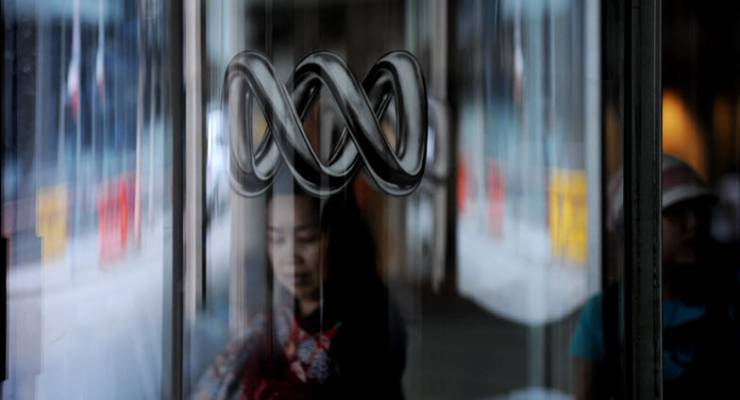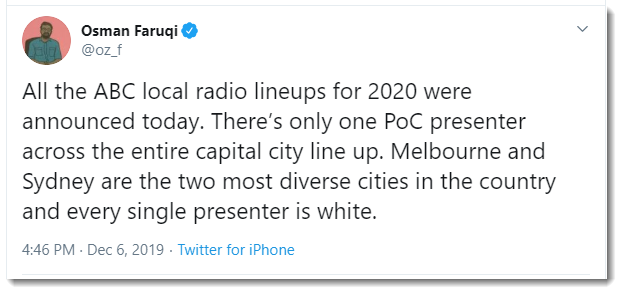
November 7 was a significant day at the ABC for two reasons.
The first was the launch of its Diversity and Inclusion Plan 2019-22 — a flashy, 31-page document about boosting gender, LGBTIQ, disability, ethnic and Indigenous representation, illustrated with photos of smiling, attractive content makers.
Under the plan, the ABC pledged to boost the proportion of culturally and linguistically diverse (CALD) employees — currently 22% of the Australian population — from 13.7% to 15% by 2022.
The second announcement of November 7 was much more widely reported: Hamish Macdonald would replace Tony Jones as host of Q&A.
He’s not the only successful white journalist replacing another successful white journalist on a flagship program. There’s also David Speers replacing Barrie Cassidy on Insiders, while Lisa Miller has replaced Virginia Trioli as co-host of News Breakfast with Michael Rowland.
Over at ABC Radio, it was confirmed that Sammy J will replace Jacinta Parsons and Sami Shah — the latter of whom is one of ABC Radio’s few presenters of colour — just two years after they took over ABC Melbourne’s breakfast program from Red Symons. This decision has angered a number of ABC contributors of colour on Twitter, as did last week’s announcement of an overwhelmingly white 2020 local radio lineup.

Responding to questions from Inq, an ABC spokesperson said managing director David Anderson and chair Ita Buttrose had “spoken publicly about ensuring that the ABC looks and sounds like and reflects contemporary Australia”.
“We have more work to do to identify, support and retain on-air talent from diverse backgrounds and are focusing on this issue as a part of an on-air talent project that is currently underway,” the spokesperson said.
And even allowing for a notable exception — Avani Dias taking over from Tom Tilley at Triple J’s Hack — 2019 has shown a gulf between the ABC’s outward ambitions and internal practices.
“The ABC is doing much better in diversity with its news presenters, nowadays — that’s to be commended,” one ABC contributor of colour tells Inq. “However, when it comes to news and analysis, there is a problem when flagship current affairs programs — from 7.30 to Four Corners — are still, by my count, staffed with 100% Anglo newsrooms.
“How this is possible in 2019 in a country where roughly one third of us are non-Anglo is beyond me.”
Speaking to Inq, a handful of Indigenous and CALD contributors have raised — on the condition of explicit anonymity — simmering frustrations and feelings of burnout that have led to a churn of POC contributors at the public broadcaster.
A sense of frustration
Many agreed that the worst departments in terms of representation were news and current affairs, radio, and comedy — where, in the words of one presenter, the best role anyone could hope for was “sidekick”.
There were no words raised against any of the new hires, but there was a deep sense of frustration that prominent TV roles have once again gone to all-white hosts.
“We’re not looking at radio, which can rotate every couple of years, we’re looking at the programs that define our national broadcaster,” one contributor says. “They are the ones that set the agenda not only for today, but are seen as the core programs of the ABC.”
“And so in a sense you’re defining the look of the ABC for the next 10 years, and that’s very short sighted.”
Another presenter claims they have heard at least two radio executives in November utter the phrase, “We tried going down the diversity route, it was too much too soon; people need to be eased into it.”
This could refer to affirmative work taken under former managing director Michelle Guthrie’s reign: one source argues that, whatever the flaws of her tenure, Guthrie was working towards representative content and “cultural bias” training which, according to one journalist Inq spoke to, received some internal backlash.
“Colleagues would openly complain in front of me and others that they were annoyed about having to tick-off boxes to include better representation,” they say.
There are exceptions, specifically children’s shows, ABC Life, drama, documentaries, and teams including The Drum and Background Briefing.
ABC Life, in the words of one presenter, is “a shining light in all of this”. It’s staffed with a mix of genders and cultures, and it represents historically underserved topics such as women’s health and mental health — something that has drawn backlash from establishment journalists.
“Both external and internal attacks on ABC Life … does feel like an attack on the needs of ABC’s younger audiences, and an attack on perhaps the only arm of the organisation representing Australia properly in its staffing and content,” said one presenter.
Culture problem
Budget cuts and attacks from outside the ABC in recent years have rattled decision-makers around both hiring and content. Employers are reportedly looking for people who can “hit the ground running”, a stipulation that does not, generally, help people with non-mainstream journalistic training.
There’s also just everyday, casual racism: one Indigenous contributor reports of being brought in and out purely for NAIDOC week TV/radio specials, and that teams wanted caricatures, “people who will say ‘deadly’ or look/sounded ‘black enough’”.
Multiple sources report having felt, even amongst supportive white colleagues, a sense that they should “feel lucky to be here”.
Another former journalist reports that “small everyday stories were spiked because there was a fear The Australian would kick [up] a fuss over it, and in one instance I was told ‘the Jewish groups won’t like it’ in relation to a pitch. ‘Not worth it’.”
The ABC spokesperson said no reports of that type had been raised with news management, but they expressed sympathy for staff who felt they were being used in a tokenistic way.
“The ABC is disappointed if some people have felt that way and hope that if they do, they could approach someone in the corporation they feel comfortable raising this matter with,” the spokesperson says.
They also noted that, on top of the Elevate Reconciliation Action Plan, the ABC offers cultural awareness training, which primarily focuses on Indigenous cultural awareness and has been completed by about 30% of staff.
Exceptions, reforms, and where to go next
On top of staffing and content issues, sources have complained about a lack of internal support mechanisms against internal racism.
“There was nowhere we could report racism,” one says. “It’s difficult to, unless it’s something very explicitly racist — like a direct comment about being a terrorist, for example. That is what most people’s understanding of racism is.”
Working as a person of colour in Australian media also means facing both emboldened, openly racist commentators and online harassment.
An ABC spokesperson said the ABC provides information, guidance and support to contributors and staff about cyber safety, and has an internal complaints process where staff could report racist behaviour.
One contributor mentions joking about yet another all-white lineup, and having the program’s producer complain to their manager.
Another person reports being told simply to “stay off social media” as advice — not, generally speaking, an option for any young media professionals.
There is hope, with one internal POC group which has met with Buttrose and Anderson — both of whom were reportedly receptive to their complaints.
The broadcaster’s hate speech guidelines go some way to addressing false balance (although reportedly would not have prevented the widely-criticised interview with US nationalist Steve Bannon) while groups like the Bonner Committee and initiatives under the Reconciliation Action Plan are making headway into incorporating Indigenous rules, knowledge, and copyright into storytelling practices.
Finally, without divulging too much, one insider outlined a concrete mechanism to be implemented across almost all departments, which will ensure the report’s targets become a “rule” rather than just a “guide”.
The ABC spokesperson said that the corporation monitors progress in reaching and reporting on diversity targets, but they do not have a quota system.
Despite any potential — and probably very likely — progress on the horizon, many of the sources Inq spoke to are planning to leave the ABC next year. Any hope for new, or remaining, employees of colour rests on the broadcaster growing representation amid Coalition pressure and slashed expenditure.








Furious as yet another change to 774. At 73 years old, tired of continual change. Sammy Sha brought different perspectives to the morning. Is the ABC like many other organisations? We support diversity as long as those in the minority know their place!
Seems to be nowadays, particularly on local radio, privileged white women have taken over the shop in the guise of ‘diversity’.
There needs to be far more diverse views (non white women academics would be a good start) on the ABC. Christine Anu is an excellent presenter and would improve with more experience but she has been shuffled to weekend evenings, which is usually on digital only because of sporting commitments. Likewise Glynn Greensmith is an excellent presenter that you would need to search hard to hear. I’d also love to hear more Asian voices on local radio or someone with a religious background in Buddhism like Meshel Laurie. Sammy Shah, while representing a diverse voice, wasn’t a great presenter (nor was his partner Jacinta Parsons for that matter) and you can’t rely on diversity alone.
First up, Crikey please can you ban the dreadful Americanism, people of colour. Just say non white or pretty much anything else. This is Australia.
As if poor Aunty hasn’t got enough problems, those within and commenters without are trying to push it down the everyone loses wormhole of lowest common demominator diversity. The dreaded undefinable casual racism has popped up and if left to run promises to gobble up thousands of hours of bureaucratic handwringing and millions of scarce dollars at the expense of the humble audience. I see the author of this piece is experienced in US style media work which explains the tone here.
I don’t care what actual skin colour or alleged imputed colour a presenter / reporter or whatever is on any medium and I reckon most abc regulars are the same. What I want is quality uncensored coverage and that’s been well under attack for the past six years with a noted drop in independent attitude. I don’t want quotas, tokenism or whiny activists pushing their way into a job because of irrelevant personal background matters. I want good people.
The ABC should stand up and be clear it’s not a place of sinecures or favouritism regardless of internally well meaning intent. Maybe check out sbs. They seem to have lots of good people of various hues so it can’t be that hard.
Wow. Just wow. “Non white” – let’s use a negative (non) to describe a person.
Meanwhile, over in the commercial world: crickets…
It should be remembered that under a conservative government only those that accept and adhere to the news limited Murdoch doctrine will ever be appointed to positions of influence and that includes the ABC , the AFP Fairwork Australia, the High Court and the AAT , there will never be a real ICAC introduced while the coalition is in power. their manifesto is the tot
al destruction of the unions because they fund the Labor party, no funds, no opposition, yet the dumb voters still vote these politically corrupted bastards in .